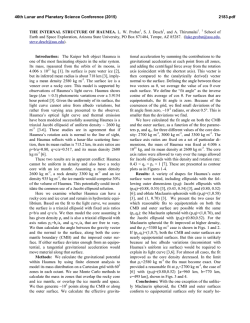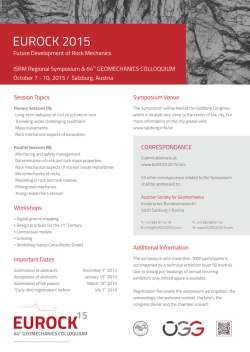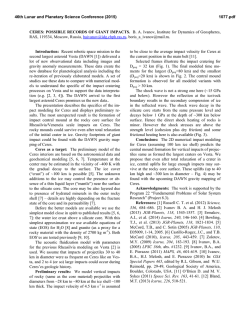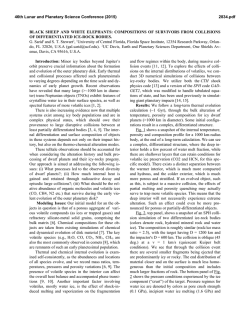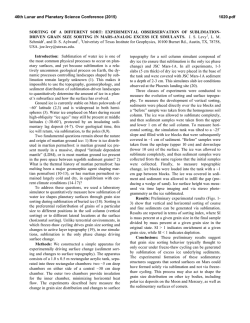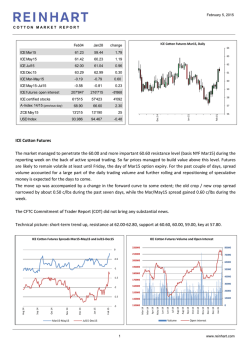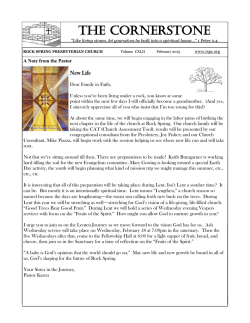
ON THE ORIGIN OF HAUMEA. S. J. Desch1 and M. Neveu1
46th Lunar and Planetary Science Conference (2015) 2082.pdf ON THE ORIGIN OF HAUMEA. S. J. Desch1 and M. Neveu1, 1School of Earth and Space Exploration, Arizona State University, PO Box 871404, Tempe AZ 85287-1404 ([email protected]) Introduction: The Kuiper belt object Haumea is one of the most fascinating objects in the Solar System. Its light curve shows large photometric variations with a 3.9-hour period, best explained by a triaxial (Jacobi) ellipsoid shape [1-4]. From such studies, and the orbits of its moons [5], a mass 4.006 x 1021 kg and a rock-like bulk density 2550-2600 kg m-3 are inferred. Despite this, its surface is pure water ice [6]. Haumea also is the largest member of a collisional family, with other family members identified because they have pure water ice surfaces as well [7]. From the orbits of the family members, the collision that generated them is inferred to have occurred several Gyr ago, but after Neptune’s migration [8], presumably coincident with the Late Heavy Bombardment (LHB) 650 Myr after formation of the Solar System [9]. These features have been explained by a collision that stripped Haumea’s icy mantle, imparted a rapid spin, and ejected fragments [7]. Haumea’s high spin seems to favor a collision between two equal-sized progenitors [10]. Haumea’s density and internal structure remain enigmatic. While models of Haumea’s origin implicitly assume it is a rocky core (> 3000 kg m-3) surrounded by an icy mantle (< 1000 kg m-3), its light curve has been modeled assuming Haumea is a homogeneous body with density 2600 kg m-3 [1-4]. In fact, Probst et al. [10] show its shape is inconsistent with a differentiated body of dense rock and thick ice crust: it must have almost uniform density. But why is its density so uniform, with a value between that of ice and rock? Here we present a scenario that explains these features. Following [11], we assume Haumea formed from the merger of two progenitors, each about 650 km in radius, with density 2000 kg m-3. We assume the collision occurs around the time of the LHB. By that point, radioactive decay has led to bodies with rocky cores and icy mantles, surrounded by thin crusts of undifferentiated rock and ice. During the collision the cores merge, and the crusts and most of the ice mantles are ejected. The structure of the new Haumea is one of rock and some ice in the core, surrounded by a thin (tens of km) ice mantle. Following the collision, rock and water in the core react to form serpentines, while undergoing “mudball convection” as envisioned by [12]. This uniformly mixes hydrated rock with density ~2900 kg m-3 throughout the interior, giving Haumea a bulk density ~2600 kg m-3. Many key assumptions underlie this scenario: 1. Does the thermal evolution of the progenitors support formation of cores before the LHB? 2. In the merged body, can mudball convection take place and thoroughly mix the material? Can the core avoid heating to the point where rock would dehydrate? 3. Is the density of hydrated rock ~ 2900 kg m-3? Here we test many of these assumptions. 1.Thermal evolution of the progenitors: We have calculated the thermal evolution of these bodies using the code of [13], modified by [14]. The code includes radiogenic heating, the antifreeze effects of ammonia, and differentiation. Modifications include parameterizations of cracking of the rocky core, heat carried by hydrothermal circulation, and heating by water-rock reactions (serpentinization). A surface temperature of 40 K is imposed. After cold (40 K) accretion of ice and dry silicate rock well after decay of 26Al, long-lived radioactivities cause ice to melt by t ≈ 65 Myr. Once ice melts, large solids sediment by Stokes flow to form a rocky core: the settling times for particles of diameter D=1 mm are 18 ΔR η / (Δρ g D2) ~ 0.2 yr, with ΔR=100 km, Δρ=2250 kg m-3, g=0.5 m s-2, and we have accounted for the fact that the viscosity of the slurry is increased by a factor (1-ϕ/ϕm)-2, above that of water (η=0.001 Pa s), where ϕ is the volume fraction of rock in the slurry and ϕm=0.64 [15]. In the water-rich melt inside the progenitors, ϕ≈0.44 and the slurry is ~4 times more viscous than water. Conceivably the fraction of solids in micron-sized grains could stay suspended in the liquid for ~105 yr, but they would be excluded from the ice when the liquid freezes, and would join the core later. At any rate, a rocky core quickly (< 108 yr) forms in the progenitors, containing most (>95%) of the mass of solids, surrounded by an ice mantle and an undifferentiated crust. In these models including rock-ice reactions, a common feature is that a pulse of heat from serpentinization at ~ 70 Myr thins the crust to only ~10 km. By about 400 Myr, subsequent radiogenic heating begins to dehydrate the rocky core. By the time of the impact, each body contains about 1.73 x 1021 kg rock (60% dry, 40% hydrated), at temperature ≈ 800 K, 0.47 x 1021 kg ice, and 0.10 x 1021 kg of crust. During the impact, the two cores merge and the outermost 13% of the mass is lost, as in [8]. 2. Post-impact thermal evolution. Following the impact, the core has total mass 3.46 x 1021 kg of rock (1.97 x 1021 kg dry olivine, 1.48 x 1021 kg serpentines), overlain by 0.55 x 1021 kg of ice. We initialize this configuration at Tinit ≈ 800 K, and impose a surface temperature 40 K. We calculate the subsequent thermal 46th Lunar and Planetary Science Conference (2015) evolution as before. Figure 1 shows temperatures at different radii and times as different colors, We find that immediately after the impact, ice is melted nearly to the surface. Hydrothermal circulation through the core is very effective, cooling it below 400 K in only 40 Myr. During this interval the rock fully hydrates, and some ice is consumed in doing so, resulting in 3.71 x 1021 kg of hydrated silicate and 0.30 x 1021 kg of ice. The core is likely to convect as a mudball, as modeled by [10]. If the core is a mud slurry, its Rayleigh number easily exceeds the critical value. We assume that convection at the boundary of the rocky core and icy mantle mixes ice into the rock (which melts to add liquid). In contrast to the progenitors’ evolution, the solids and liquid cannot demix: the volume fraction of solids is ϕ > 0.8 > ϕm=0.64. The viscosity of the slurry is orders of magnitude higher than that of water, though probably << 102 Pa s, at least until it freezes. We calculate that nearly all of Haumea was > 273 K and convecting soon after it formed, but that today convection is restricted to the innermost 340 km. “Mudball convection” has the effect of homogenizing Haumea’s interior, as well as cooling it. Temperatures do not rise to the point where rock dehydrates. Figure 1: thermal evolution of post-impact Haumea. 3. Density of hydrated rock. We assume that inside Haumea all rock becomes fully hydrated, leaving only a fraction of the ice. If the rock were pure olivine (Mg1-x,Fex)2SiO4, with x=0, then the reaction Mg2SiO4 (forsterite) + (3/2) H2O --> (1/2) Mg3Si2O5(OH)4 (chrysotile) + (1/2) Mg(OH)2 (brucite) would convert 1 kg of olivine (ρ=3270 kg m-3) and 0.192 kg of ice (935 kg m-3), with combined average density 2332 kg m-3 into 0.985 kg of chrysotile (2503 kg m-3) and 0.207 kg of brucite (2390 kg m-3), with combined average density of 2505 kg m-3. For a cosmic abundance of Fe, x=0.289 [14], 1 kg of olivine reacts with 0.129 kg of ice, with combined average density 2710 kg m-3, to produce 0.826 kg of chrysotile, 0.281 kg of Fe3O4 (magnetite, 5150 kg cm-3), and 0.020 kg of SiO2 (quartz, 2620 kg m-3), with an average density 2899 kg 2082.pdf m-3. For CI abundances [16], each mole of Si atoms results in 68.73 g of pyroxene, 58.38 g of olivine (both with x=0.2892), 39.11 g of troilite, 8.64 g of gehlenite and 1.51 g of spinel, with combined density 3679 kg m-3. Assuming that the pyroxenes and olivines react with 13% their mass in ice, and those phases increase in density by 8% (as above, for olivine), the final average density of the assemblage containing hydrated rock is 2936 kg m-3. We conclude that 2900 kg m-3 is the approximate density of hydrated rock inside Haumea. Using the masses above, 3.71 x 1021 kg of hydrated silicate and 0.30 x 1021 kg of ice, the core extends to 673 km and Haumea’s mean radius to 726 km, yielding an average of Haumea 2530 kg m-3. A more careful geochemical calculation would refine this density. Self-compression may also increase it slightly. For now it is clear that a body composed of hydrated silicates with density ~ 2900 kg m-3 and an ice mass equivalent to a 50 km thick crust is plausible and reproduces Haumea’s overall density. Mudball convection can mix the ice into the interior, thinning the crust (e.g., to 25 km), and helping to satisfy constraints on Haumea’s interior structure [11]. Conclusions: We find support for the scenario of [8] in which Haumea forms from two progenitors of radius 650 km and density 2000 kg m-3, which collide in a “graze-and-merge” impact. If the impact occurs around the LHB, the progenitors have formed rocky cores. Relatively thin crusts, due to hydrothermal heating, reduce the amount of mass that must be lost in the impact. Following the impact, high initial temperatures but rapid cooling help to hydrate the rock, drive mudball convection, and homogenize its interior. Using simple first-principles modeling of this scenario, we predict the average density of Haumea would be 2530 kg m-3, very consistent with observations. References: [1] Rabinowitz, D.L. et al. (2006) ApJ, 639, 1238-1251. [2] Lacerda, P. and Jewitt, D.C. (2007) AJ, 133, 1393. [3] Lellouch, E. et al. (2010) A&A 518, L147-151. [4] Lockwood, A.C., Brown, M.E. and Stansberry, J. (2014) Earth, Moon & Planets 111, 127-137. [5] Ragozzine, D. and Brown, M.E. (2009) AJ 137, 4766-4776. [6] Trujillo, C.A. et al. (2007) ApJ 655, 1172-1178. [7] Brown, M.E., et al. (2007) Nature 446, 294-296. [8] Volk, K. & Malhotra, R. (2012) Icarus 221, 106-115. [9] Tsiganis, K. et al. (2005) Nature 435, 459-461. [10] Leinhardt, Z.M., et al. (2010) ApJ 714, 1789-1799. [11] Probst, L.W. and Desch, S.J. (2015) LPSC XLVI, Abstract #????. [12] Bland, P.A. et al. (2013) LPSC XLIV, Abstract #1447. [13] Desch, S.J. et al. (2009) Icarus 202, 694-714. [14] Neveu, M. et al. (2015) JGR, in press. [15] Mueller, S. et al. (2010) Proc Roy Soc A 466, 1201-1228. [16] Lodders, K. (2003) ApJ 591, 1220-1247.
© Copyright 2025
